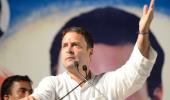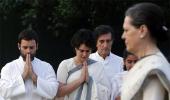India is mushrooming with Deve Gowda wannabes because being a former prime minister is better than being a former chief minister, says Shekhar Gupta.

Here is a famous story from the rich folklore of The Indian Express -- where I worked for 25 years in two spells. One eminent friend asked the late Ramnath Goenka why he wasn't giving his editor an extension of contract. "He is such a saint, I can't believe you don't want him for longer," complained the eminent friend.
"Bhai, he is Saint George Verghese, I agree. But my Indian Express is Shiv ji ki baraat. It is too much for a saint to handle," said the patriarch.
Now, Shiv ji ki baraat is a millennia-old metaphor for a riotously merry mob of diverse living species, ghosts, spirits, apparitions and witches, high on the brew or concoction of their choice.
Tell me if this isn't how today's anti-BJP Opposition parties look across the country.
The only reason Shiv ji ki baraat was still kept in reasonable order was the stature and the unchallenged leadership of the groom-to-be, Lord Shiva. In this modern version, every baraati is a groom-to-be.
This is why Narendra Damodardas Modi and his strategists are smiling, tossing away the blues after the state poll losses.
Let's start counting. There is the Congress, led by India's most prominent new Shiv-bhakt, with four allies of reasonable reliability: Sharad Pawar's NCP, M K Stalin's DMK, Lalu Prasad's RJD and H D Deve Gowda's JD-S. Let's call it the second front (NDA being the first).
Then, the SP and the BSP are going their own way together in an Uttar Pradesh gathbandhan. As things stand, in the election campaign, these two will attack the BJP, but also the Congress, and vice-versa. Let's call them the third front, if only for convenience.
Yet another alliance of sorts is now on display with Mamata Banerjee's show of strength. This includes the Congress, the SP, the BSP, and many of the reigning regional satraps, including the DMK, Chandrababu Naidu's TDP and Arvind Kejriwal's AAP. This is some kind of a fourth front.
Then there are Naveen Patnaik's BJD, the TRS of K Chandrashekara Rao and Jagan Mohan Reddy's YSRCP, who are out of all these groupings, and waiting for a break some place. These are our fifth, sixth, seventh fronts and so on.
And finally, we have the Left, whom nobody wants. This is the state of the anti-BJP parties today, a Shiv ji ki baraat without a groom.
This can be sliced and diced further. If you look at Mamata's stage, the Congress and the AAP are there, but still bitter rivals in Delhi and Punjab. The TDP has not yet sealed an alliance with the Congress, given the uncertainty over the mutual transfer of votes after the debacle of Telangana. The SP and the BSP are set to fight the Congress to a repeat humiliation in Uttar Pradesh.
Patnaik, as always, is keeping his options open. His is the least ideological of all regional parties. He can afford to be, because he has almost no dependence on the Muslim vote.
KCR is sure he is prime minister material. The Congress and the Left are bitter rivals in Kerala. The only thing that brings the leaders of these diverse parties together, even on a rally stage, is their opposition to the BJP. But there is little ideological glue between any of them.
Barring the Congress, none of these parties can reach the number of 50.
Their best hope: Keep the BJP below 170, the Congress at 100, and then build an alliance of the rest that forces the Congress to support it from outside.
The last time we saw this movie, it was called Deve Gowda's United Front. In such an election, each one of these stalwarts would see a chance for tenancy at Lok Kalyan Marg, however short.
Being a former prime minister for the rest of your life is better than being a former chief minister.
In 1996, the late comrade Harkishan Singh Surjeet had to conjure up a Deve Gowda from some place. Today, the Opposition has a gaggle of 'main-bhi-Gowda' wannabes.
India isn't about to repeat in 2019 what it did in 1996 and felt stupid. That is why you find the confidence and the smiles back on the BJP faces.
Mr Modi and his strategists believe the contest this summer will bear no resemblance to the recent state elections or the many recent by-elections they lost.
The Opposition's disunity, conflicting ambitions, personal antagonisms and the one-point agenda of 'Modi Hatao' have convinced them that India is headed for a 1971, Indira-versus-the-rest kind of elections. Where all pundits added the voter arithmetic and pronounced that she was going to lose, she won a landslide on the slogan of 'Garibi Hatao' versus 'Indira Hatao.'
In a state election, as in Madhya Pradesh, Rajasthan or Chhattisgarh, you can go against the incumbent without a chief ministerial candidate. Your voters know the two or three contenders within your party and are not particularly polarised in terms of personal loyalties.
In a national election, it is dangerous to say we will fight Mr Modi state by state, and also each other at the same time. He will turn it into a 'so which among these will be your new Gowda' campaign. He can, and would, then cut you down piecemeal.
While the BJP compares 2019 to 1971, the fact is that it could be even better for them for two reasons. One, unlike in 1971, today a very large number of seats will go to regional parties.
Several of them, from the Dravidian parties to Mayawati and even Mamata, have zero or negotiable ideological hang-ups, having partnered or opposed both the BJP and the Congress. So, they need to keep their options open.
The optimum BJP plus Congress number in a general election is 350 out of 543. Anything below 300 starts opening up possibilities.
And in case it is below 275, these parties will hunt in a fully bivalent manner. They continue to be likely allies for the BJP too.
Second, in 1971, it was still possible for major Opposition parties, especially in the heartland, to be united only by sheer anti-Congressism. Today, there is strong anti-BJPism, but the competing anti-Congress impulse endures.
The prospect of a broken mandate is encouraging many of these below-50-seat stalwarts to fantasise about a non-BJP, non-Congress government. The most vocal proponent of this is Telangana's KCR.
Now, arithmetic tells you the following:
Even if the BJP and the Congress together count for less than 250, there is no way the rest could reach 272 without one of these big two supporting them from outside. That means a prime minister on daily wages, like V P Singh, Chandra Shekhar, H D Deve Gowda or I K Gujral.
Next, because no leader other than Mr Modi or Rahul Gandhi is even theoretically capable of crossing 50, a non-BJP/non-Congress leader who others would tolerate for more than a year, forget respecting him/her for five years, is an impossibility.
Such a government, a riotous Shiv ji ki baraat without a leader or a groom, would fall apart soon. Remember, how even a saint like Jayaprakash Narayan failed to keep one such flock together in 1979?
Finally: If the Opposition insists on going leaderless, Mr Modi will only need to read out this script and the voters would most likely listen to him. Even if they don't, if a split election produces a 10-month-wonder again, it will subsequently give Amit Anilchandra Shah the opportunity to make his boast of 50 years of BJP rule.
By special arrangement with The Print











